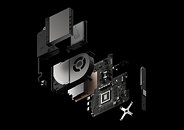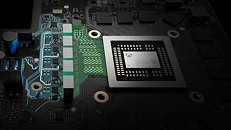Monday, June 12th 2017

Xbox One X Hardware Specs Give Gaming Desktops a Run for their Money
Microsoft Sunday dropped its mic with the most powerful game console on paper, the Xbox One X, formerly codenamed "Project Scorpio." The bottom-line of this console is that it enables 4K Ultra HD gaming at 60 Hz. Something like this requires you to spend at least $1,200 on a gaming desktop right now. Unlike a Windows 10 PC that's been put together by various pieces of hardware, the Xbox One X is built on a closed ecosystem that's tightly controlled by Microsoft, with heavily optimized software, and a lot of secret sauce the company won't talk about. The console still puts up some mighty impressive hardware specs on paper.
To begin with, at the heart of the Xbox One X is a semi-custom SoC Microsoft co-developed with AMD, built on TSMC's 16 nm FinFET node (the same one NVIDIA builds its "Pascal" GPUs on). This chip features a GPU with almost quadruple the single-precision floating point compute power as the one which drives the Xbox One. It features 40 Graphics CoreNext (GCN) compute units (2,560 stream processors) based on one of the later versions of GCN (likely "Polaris"). The GPU is clocked at 1172 MHz. The other big component of the SoC is an eight-core CPU based on an unnamed micro-architecture evolved from "Jaguar" rather than "Bulldozer" or even "Zen." The eight cores are arranged in two quad-core units of four cores, each; with 4 MB of L2 cache. The CPU is clocked at 2.30 GHz.The third major component of the Xbox One X SoC is the 384-bit wide GDDR5 memory controller, wired to 12 GB of memory. This memory is used both as system- and graphics-memory, and is the most ideal implementation of AMD's hUMA (heterogeneous unified memory architecture), where there's no visible partition between the system and graphics memory on the physical memory, and depending on the usage scenario, any amount of memory can be used by the CPU and GPU components. Developers are still forced to build their games under the assumption that the system only has 8 GB of memory; so that the remaining 4 GB is used as a kind of "guarantee" that 4K UHD @60 Hz runs smoothly. The total memory bandwidth available is a staggering 326 GB/s.
The SoC features an integrated audio CODEC with 7.1-channel output over HDMI, with support for Dolby Atmos, and HRTF, a new audio format Microsoft developed for the Hololens, which is optimized for VR.
A 1 TB 2.5-inch SATA hard drive comes standard on the Xbox One X. You can swap this drive out for larger HDDs, or faster SATA SSDs. You can also plug in external storage devices over the console's USB 3.0 ports. The console's operating system resides on a smaller eMMC chip that isn't accessible to end-users. The 1 TB HDD is used to store games you've downloaded from your online library à la Steam.
Microsoft switched from bulky external power bricks to internal PSUs with the Xbox One S, and the trend carries forward with the Xbox One X. Powering the whole thing is a 275W internal power-supply. A large fan-heatsink cools the SoC and GDDR5 memory chips.
Source:
Eurogamer.net
To begin with, at the heart of the Xbox One X is a semi-custom SoC Microsoft co-developed with AMD, built on TSMC's 16 nm FinFET node (the same one NVIDIA builds its "Pascal" GPUs on). This chip features a GPU with almost quadruple the single-precision floating point compute power as the one which drives the Xbox One. It features 40 Graphics CoreNext (GCN) compute units (2,560 stream processors) based on one of the later versions of GCN (likely "Polaris"). The GPU is clocked at 1172 MHz. The other big component of the SoC is an eight-core CPU based on an unnamed micro-architecture evolved from "Jaguar" rather than "Bulldozer" or even "Zen." The eight cores are arranged in two quad-core units of four cores, each; with 4 MB of L2 cache. The CPU is clocked at 2.30 GHz.The third major component of the Xbox One X SoC is the 384-bit wide GDDR5 memory controller, wired to 12 GB of memory. This memory is used both as system- and graphics-memory, and is the most ideal implementation of AMD's hUMA (heterogeneous unified memory architecture), where there's no visible partition between the system and graphics memory on the physical memory, and depending on the usage scenario, any amount of memory can be used by the CPU and GPU components. Developers are still forced to build their games under the assumption that the system only has 8 GB of memory; so that the remaining 4 GB is used as a kind of "guarantee" that 4K UHD @60 Hz runs smoothly. The total memory bandwidth available is a staggering 326 GB/s.
The SoC features an integrated audio CODEC with 7.1-channel output over HDMI, with support for Dolby Atmos, and HRTF, a new audio format Microsoft developed for the Hololens, which is optimized for VR.
A 1 TB 2.5-inch SATA hard drive comes standard on the Xbox One X. You can swap this drive out for larger HDDs, or faster SATA SSDs. You can also plug in external storage devices over the console's USB 3.0 ports. The console's operating system resides on a smaller eMMC chip that isn't accessible to end-users. The 1 TB HDD is used to store games you've downloaded from your online library à la Steam.
Microsoft switched from bulky external power bricks to internal PSUs with the Xbox One S, and the trend carries forward with the Xbox One X. Powering the whole thing is a 275W internal power-supply. A large fan-heatsink cools the SoC and GDDR5 memory chips.




132 Comments on Xbox One X Hardware Specs Give Gaming Desktops a Run for their Money
But if you think about it you had to spend 500 bucks on the first console to then spend other 500 on the good version. So unless you didn't have the previous version the bang for the buck theory is bullshit.
I welcome it, it will make 4K HDR 60Hz a standard and we will benefit from it, with more TV and monitor options and loemwer prices, games better optimized to X86/64 and ready to utilize newer instructions and hardware.
My current Xbox One sits in it's box for this reason alone. I don't care about gaming. I care about replacing a cable box (HDHomerun Prime - network cablecard tuner), streaming (Plex, Netflix, Amazon, etc), and the ability to control all my devices with one remote and it not being based on ancient IR technology... hence the need for HDMI-CEC.
As for this whole gamepad talk:
Hasn't every cross platform (console/PC) server ended in segregation? Has anyone strolled into an FPS tournament with a controller and won?
Also, weren't controllers quite popular for fps at one point?
It's impossible to win the price game when you're going up against enormous bulk and being able to take a loss.
I'd think that someone winning a PC FPS tournament with a controller would make the news rounds. I don't follow such things though, which is why I asked.
275W power supply is worrying though isn't it? I mean it is advertised for 4k 60hz is it not??
These specs can barely be considered mid range today, and by next year Volta will demote this performance level down to the "low end". This hardware is not capable of rendering high detals in 4K, just as the old Xbox One couldn't render high details in ~1080p.There is nothing inherently in consoles making them perform better at rendering the same. Console games are usually calibrated for a target frame rate on that specific hardware, but that does not mean it will perform better per TFlop/s etc.
The xbox one x has 4.3 times the raw tflop/s, much newer architectures with much better IPC getting it to something like 5.5-6 times the power realistically, then there is the memory getting it to 6.5-7 times the performance, then there is the more dx12-like API which gets it to 7-8 times-ish performance of xbox one (s) and lastly the better dev kit should mean greater optimization by devs.
7-8 times xbox one performance should be adequate for 4k60.
And BTW; GTX 1070 will only run the most demanding games in 1080p, not 4K. It's not nearly high-end, and this console is even slower.
DX12 stuff definitely helps consoles right now, so keep that in mind.
Consoles are simply rendering at lower details.